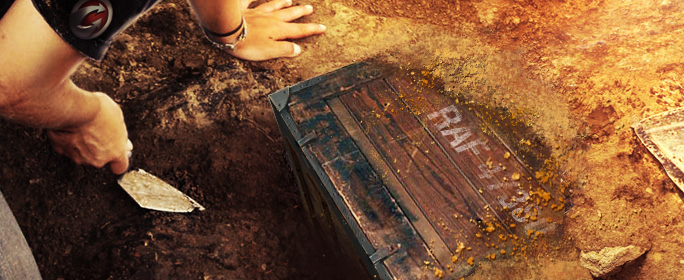-
![LANG-CODE-KEY]() LANG_NAME_KEY
LANG_NAME_KEY

Hello! My name is Dr. Adam Booth. I am a near-surface geophysicist at Imperial College London and will be accompanying Wargaming’s expedition to Myanmar as part of the geophysics team. I have a personal connection to the Spitfire project, since the Spitfire’s designer – Reginald Mitchell – hails from my home town of Stoke-on-Trent. But as a scientist, I have to set aside such considerations and remain completely objective about what we’ll find, until we pull a Spitfire out of the ground.
Geophysics is a broad discipline. My particular specialty falls under the umbrella of ‘exploration geophysics’ – essentially, the use of physical principles to detect and characterize a buried target. A well-known application is in the hydrocarbons industry, where seismological principles are used to detect and monitor subsurface oil reserves. In my own research, I use seismology on glaciers to understand the controls on ice flow. When the arctic cold gets too much, I head out to the desert to work on archaeological projects (e.g., here and here!), where my geophysical surveys play a valuable role in managing and planning the excavation of an archaeological site. This is precisely the role I play in the Myanmar Spitfires investigation.

Most of my past archaeological collaborations involve a target from remote antiquity, so it was a novel challenge to focus on objects reportedly buried within living memory. I first met David in 2003, whilst between projects at the University of Leeds. David had been consulting with Dr Roger Clark, a Leeds geophysicist (and my future PhD supervisor and colleague), about using geophysics for finding buried aircraft and their components – both at the rumored site in Myanmar, and at other locations in the UK.
One such location was RAF Colerne, an airbase near Bristol, where David believed that a number of Spitfire engines had been dumped. David arranged for a Leeds geophysics team, including Roger and myself, to conduct surveys for the suspected dump-site. On this occasion, the geophysics drew a blank: there was no clear evidence of the burial and we couldn’t confidently recommend a dig site. And then, early in 2004, my phone rang.

I was rather taken aback when David asked me to travel with him to Myanmar; it took a firm reality-check to realise he’d said “Burma”, and not “Birmingham”! The target: dozens of buried Spitfire aircraft, in their delivery crates. Despite complementary accounts from eye-witnesses, the Myanmar government had instructed David that he’d need harder evidence of the burial if he was ever to obtain an excavation permit: geophysics was one powerful means of obtaining this. Therefore, six months later, I found myself standing in a swamp next to the runway of Mingaladon Airport, trying to stay dry in a monsoon while avoiding snakes, performing an electromagnetic survey to detect buried Spitfire aircraft!
Electromagnetic, or EM, surveying gives you a measure of the electrical conductivity of the subsurface. To a conflict historian, a buried Spitfire may represent a rich source of archaeological evidence, while a veteran may perceive a symbol of pride in a job well done; the exploration geophysicist sees it as something rather more mundane – a hunk of metallic components buried at some depth in the ground! However, it’s properties of metals that I’m exploiting in the EM survey: in simple terms, metals conduct electricity, soil does not. If the EM equipment records an area of consistently increased electrical conductivity, I can suggest that this is the location of the buried target.

Below is a subset of the EM data that I acquired in 2004, using a Geonics EM-34 instrument. You’re looking at data in ‘map-view’ – the survey grid is 190 x 100 m in area, and the colour scale represents the observed electrical conductivity. For reference, Mingaladon Airport’s runway is parallel to the lower edge of the grid (in fact, it runs along 0 m on the y-axis!). The highest electrical conductivities correspond to the red colours and, fairly obviously, there are two discrete areas of interest.

The map does not tell us anything about whether we’re looking at Spitfires. What it does show, however, is that there is something electrically conductive in the ground, at two locations within the survey site. The responses are high enough to be indicative of metal – but a war leaves behind plenty of metallic debris so we can’t leap to the conclusion that there are Spitfires buried at this location. It is rather compelling, however, that the location of the left-hand anomaly exactly matches the burial site identified by David Cundall’s eye-witnesses.
Nonetheless, the geophysical evidence was sufficiently compelling that, on the last day of the 2004 survey, the Myanmar government permitted a trial excavation. After a final formality – a Buddhist blessing to ward off any evil spirits that may be disturbed! – a mechanical excavator arrived on site and the dig began. The hole grew and grew until finally, at a depth of around 5 m, a wooden plank was revealed. An isolated plank, or the top of a delivery crate…? Unfortunately, This was precisely the moment when the government halted the excavation and we had to leave. So near but so far, the hole was backfilled; Mingaladon would hold onto its secrets for another nine years.